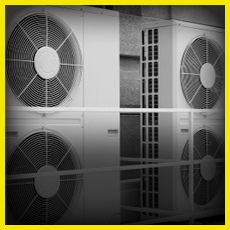OVERVIEW
Air conditioners that cool our offices, stores, schools, and restaurants used 1.1 million GWh of energy1 and emitted 151.3 megatons of CO2 equivalent in 2010.2 Adding the electricity and natural gas used by heating and ventilation, commonly provided by the same system, the total energy expenditure used by commercial-scale heating, ventilation, and air conditioning (HVAC) systems topped 2.5 million GWh3 and accounted for more than 7.5% of U.S. GHG emissions.4 Americans can vastly reduce the energy we use to stay comfortable during hot summers and cold winters with two strategies: make HVAC systems more efficient and reduce our need to use them.
ANALYSIS
The easiest way to reduce the use of HVAC equipment is by improving a building’s shell— the windows, walls, and insulation. These ideas are covered in the Commercial Building Materials component. In addition to a better-sealed building envelope, some HVAC use could be eliminated with better controls,5 system maintenance,6 and duct insulation.7 These projects are relatively low cost, but because of the payback period many buildings have been reluctant to upgrade.8 These types of projects could reduce energy use by as much as a third,9 which would lower energy expenditures by $16 billion10 and save 160,000 GWh of energy if implemented in the 5% least efficient buildings.11
While it is difficult and expensive to switch to a different type of HVAC system, like from a boiler to a furnace,12 merely upgrading a system generally improves efficiency by more than 20%.13 Although commercial systems last between 15 and 35 years,14more than 4% of commercial-scale HVAC systems are replaced annually. If each of these systems achieved a 20% efficiency gain,15 businesses would save an aggregate $500 million16 and CO2 emissions from commercial and industrial HVAC would decrease by 3 megatons each year.17 Paired with increasing equipment efficiencies, the cumulative effect would reduce U.S. carbon emissions by 39 megatons,18 the equivalent of emissions from the entire state of Alaska.19
IMPLEMENTATION
Several policies could have an impact on both sides of reducing HVAC energy use – reduced usage and more efficient systems.






